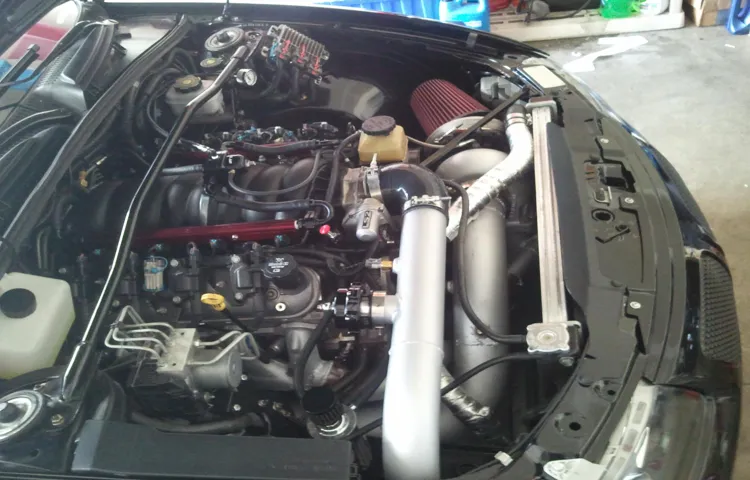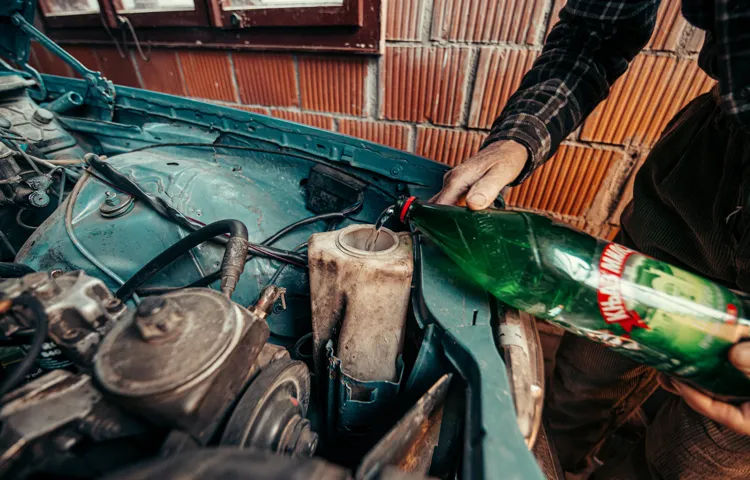Hey there, have you ever spilled coolant? It’s a common mishap that can happen to even the most seasoned car owners. Whether it’s from a loose cap, a crack in your radiator, or simply overfilling your reservoir, coolant spills can make a mess and be harmful to both you and the environment. So, what happens when you spill coolant? In this blog post, we’ll take a closer look at the effects of a coolant spill, what to do if you find yourself in this situation, and how to prevent it from happening again in the future.
So, buckle up and let’s dive in!
Table of Contents
Introduction
Spilling coolant while pouring can be quite hazardous, especially for individuals who are not trained to handle such fluids. Coolant is made up of a mixture of water, antifreeze, and other additives that help to regulate the engine’s temperature. If spilled, the coolant can cause harm to your skin and make the area slippery, leading to slips and falls.
Moreover, it is essential to clean up the spilled coolant immediately as it can cause damage to the garage floor or driveway. The coolant contains chemicals that can corrode the concrete, leading to expensive damages in the long run. Besides, inhaling the coolant’s fumes can be harmful to your health, causing nausea, dizziness, and even respiratory problems.
Therefore, if you spill coolant while pouring, it is crucial to take immediate steps to contain the spill, clean it up and dispose of the waste appropriately to avoid further damage.
Definition of Coolant
Coolant is a term used in the engineering realm to describe a fluid used to maintain a stable temperature in machinery, engines, or electronic devices. These fluids can be either gas or liquid and serve the purpose of dissipating the heat generated during operation. Most commonly, the term coolant refers to liquids such as water or oil that are circulated through cooling systems in engines and machines, absorbing heat and transferring it to a radiator where it is released into the environment.
Coolants are crucial in maintaining the performance and efficiency of machines and engines as overheating can lead to breakdowns, reduced lifespan, and even damage. Therefore, it is important to choose the appropriate coolant for each application, considering factors such as viscosity, boiling point, corrosion resistance, and compatibility with other components.

The Risks of Spilling Coolant
Coolant spills can be a major source of concern for drivers and mechanics alike. Not only does coolant contain toxic chemicals that can harm the environment and wildlife, but it can also pose a serious threat to human health. For example, prolonged exposure to coolant vapors can lead to respiratory issues and even neurological problems.
Additionally, coolant can create slippery surfaces that increase the risk of slip-and-fall accidents. This is why it’s crucial to take proactive steps to prevent coolant spills, such as ensuring all caps and hoses are secure and regularly inspecting cooling systems. By doing so, we can help keep ourselves, our customers, and the environment safe and healthy.
Actions After Spilling Coolant
Uh-oh, did you spill some coolant while pouring it into your engine? Don’t panic, but take action quickly. Coolant is essential to keep your engine from overheating and to prevent corrosion, but it can be hazardous when spilled. The first thing to do is to ensure that the engine is cold before trying to clean up the spillage.
Hot coolant can burn your skin. Next, wear gloves and protective eyewear to avoid skin and eye contact with the coolant. Contain the spill by using a spill kit or absorbent material.
Avoid using ammonia-based cleaners as these can cause a dangerous reaction when mixed with coolant. Lastly, safely dispose of the contaminated materials in accordance with your local regulations. Remember that coolant is a hazardous material and should be treated with respect.
Protective Gear and First Aid
When it comes to spilling coolant, the first thing to do is protect yourself. Wear protective gear such as gloves, safety goggles, and a face mask. Coolant can cause skin irritation, and ingesting it can lead to serious health problems.
If the spill is in a confined area, open windows and turn on fans to improve ventilation. After taking precautions, the next step is to contain the spill. Find an absorbent material such as kitty litter, sawdust, or sand, and spread it over the spill area.
Wait for it to absorb the coolant, and then sweep it up and dispose of it in accordance with local regulations. Once the spill is cleaned up, it’s important to remember to properly sanitize the area with soap and water to prevent any potential health risks. By taking these steps, you can quickly and safely handle a coolant spill while minimizing any harmful effects.
Clean Up Methods
When it comes to spilling coolant, there are a few actions that need to be taken to ensure proper clean up and prevent any potential hazards. First and foremost, it’s important to wear protective gloves and goggles to avoid any skin or eye irritation. Once you’re suited up, stop the source of the spillage and contain the area with absorbent materials like sand, clay, or kitty litter.
Scoop up as much of the coolant-soaked material as possible and dispose of it properly according to local regulations. Next, use a spill kit to soak up any remaining coolant on the ground, making sure to cover the entire area. Finally, use a degreaser to clean up any residual coolant left on surfaces.
Always remember to properly dispose of any contaminated materials and rinse the area thoroughly with water afterwards to ensure it is safe for people and pets. By following these cleanup methods, you can ensure a safe and efficient cleaning process after spilling coolant.
Disposal Regulations
When it comes to spilling coolant, it’s important to take immediate action in order to prevent environmental damage and potential health risks. The first step is to contain the spill using absorbent materials such as kitty litter or sand. Once the spill is contained, the coolant must be disposed of properly according to regulations.
This may involve contacting a hazardous waste disposal service or checking with local authorities to determine proper disposal methods. Dumping coolant down the drain or in the trash is not only illegal, but it can also harm the environment and contaminate water sources. It’s important to always follow proper disposal regulations and take responsibility for any spills that occur in the workplace or at home.
By taking these actions, we can all do our part to protect the environment and our communities.
Preventing Coolant Spills
Spilling coolant while pouring can be a disaster, but thankfully, there are ways to prevent it from happening. Coolant, also known as antifreeze, is a fluid used in automobiles to regulate the temperature of the engine and prevent it from overheating. If you spill coolant, it can be harmful to both the environment and your health.
Coolant is toxic and flammable, so it’s important to clean up any spills immediately. In addition to health and safety concerns, spills can also cause damage to your vehicle’s paint job. To prevent spills from happening in the first place, make sure you use a funnel to pour the coolant into the reservoir.
Be sure to pour slowly and keep an eye on the level of the coolant, as overfilling can also cause spills. With a little bit of caution and attention, you can avoid spillage and keep your engine running smoothly.
Proper Handling Procedures
Coolant spills can be costly and hazardous if not handled properly. It is important to take preventative measures to avoid spills from occurring in the first place. One way to do this is to ensure that all equipment is properly maintained and in good working condition.
Additionally, it is important to use the appropriate containers for transporting and storing coolant. These containers should be labeled clearly and kept in a designated area to prevent accidental spills. Workers should also be trained on proper handling procedures and should be aware of the hazards associated with coolant spills.
By taking these preventative measures, the risk of coolant spills can be greatly reduced, leading to a safer and more efficient workplace.
Equipment Maintenance
Equipment maintenance is crucial to avoid unexpected breakdowns, reduce repair costs and extend the lifespan of machines. One area that requires special attention is coolant systems. Coolant spills can cause severe environmental damage, disrupt operations, and create health risks for personnel.
So, how can you prevent coolant spills? Firstly, ensure that all equipment and machinery are regularly serviced and inspected for leaks, cracks, or faulty clamps. Secondly, train operators and maintenance personnel on the proper handling procedures and emergency response plans to contain spills. Thirdly, install drip pans and secondary containment systems to minimize the risk of leakage.
By following these measures, you can maintain an effective and safe coolant system. Remember, neglecting coolant maintenance can result in significant costs, damage to equipment and reputation, and legal fines. Therefore, take a proactive approach to coolant management to protect yourself, your team, and the environment.
Conclusion
Spilling coolant while pouring is no joke, especially if you’re a car enthusiast. Not only does it create a mess, but it can also damage your engine and affect its performance. It’s a slippery slope, one that could leave you with a coolant-covered garage floor and a vehicle that’s in no condition to hit the road.
So, if you want to avoid being the unfortunate victim of a coolant spill, take it slow and steady when pouring, keep a steady hand, and be sure to mop up any spills as soon as they occur. Your engine and your garage floor will thank you!”
FAQs
1. What should you do if you spill coolant while pouring? A: If you spill coolant while pouring, you should immediately clean it up with a rag or absorbent material to prevent it from becoming a slip hazard. 2. Can spilling coolant cause damage to your vehicle? A: Depending on where the coolant is spilled, it can cause damage to some components of your vehicle, such as the hoses, belts, and electrical connections. It’s best to clean up the spill as soon as possible to prevent any damage from occurring. 3. Is it safe to touch spilled coolant? A: No, it’s not safe to touch spilled coolant with your bare hands. Coolant contains chemicals that can irritate your skin and may cause an allergic reaction. You should always wear gloves when handling coolant and clean up any spills promptly. 4. How do you dispose of spilled coolant? A: Spilled coolant should be disposed of properly according to local regulations. Most areas have guidelines for handling hazardous waste, and coolant is considered hazardous. It’s best to contact your local waste management department for guidance on how to dispose of spilled coolant. 5. Can you reuse spilled coolant? A: It’s not recommended to reuse spilled coolant because it may have become contaminated with dirt, debris, or other fluids. Coolant is a vital component in your vehicle’s cooling system, and it’s essential to use clean and proper coolant to ensure your engine’s longevity. 6. Will spilling coolant affect your engine’s performance? A: Yes, spilling coolant can affect your engine’s performance. If the engine loses too much coolant, it will overheat, causing damage to the engine. Overheating can cause warping of the engine block, head, or some of the other critical components. 7. How do you prevent spilling coolant while pouring? A: To prevent spilling coolant while pouring, you should use a funnel to guide the coolant into the reservoir or radiator. It’s also a good idea to check the coolant level before pouring to avoid overfilling. Additionally, a steady hand and a clear workspace can help prevent accidents and spills.


